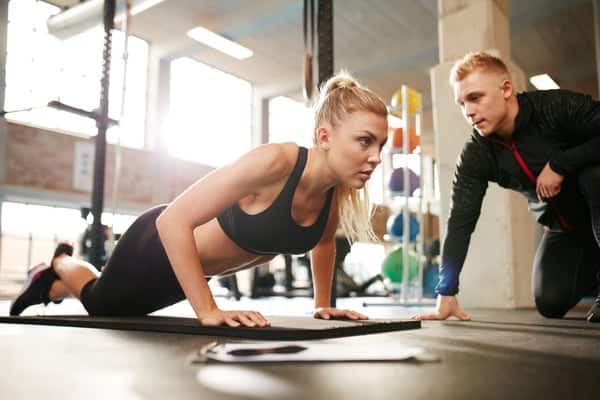Are you looking to challenge your male clients? Or maybe you’re interested in providing more fitness opportunities at your local gym?
While many people are guilty of associating Yoga as just a way to relax and ease through a workout, it’s also very physically challenging. If your client is prone to injury or needs to challenge their body in different ways, we challenge you to incorporate these two beginner Yoga workouts for men into the next session. Or integrate a program at your local gym.
At AFPA we are huge advocates for leading by example. With that in mind, the best way to guide your clients through a seamless sequence of movements is to practice them yourself. Just like you would test out that new strength training routine, test out these next few Yoga moves.
Our Favorite Yoga Workout Plans for Men
Sun Salutations
This sequence of poses revolves around Downward Facing Dog and the Standing Forward Bend. Both poses relieve tension in the hamstrings and hips. Standing Forward Bend is also good for stretching out the calves, while Downward Facing Dog can relieve lower back pain and stretch out the shoulder muscles.
1. Start with your feet together and hands at your side.
2. Bring your arms up, reaching straight above your head and stretching out your spine, back muscles, arms muscles and legs length wise. Hold for 5 deep breaths.
3. On your exhale, sweep your arms down, bending at the hips, keeping your butt tucked in and ending in a Standing Forward Bend with your hands flat on the floor. If needed bend your knees. Keep you shoulder and neck relaxed, allowing your head to hang down.
4. As you inhale, flatten your back and rise slightly to come to Standing Half Forward Bend.
5. Exhale and drop back into Standing Forward Bend, deepening your stretch.
6. Inhale and step back with the right foot into Low Lunge. The right knees rests on the floor and your hands stretch up above your head. Keep your left foot fixed in place, bending at your left knee. Hold for 5 breaths.
7. On your last exhale, step your left foot back, next to the right, shoulder length apart. Straighten your knees, keep your hips high and your shoulders pressed back. This pose is called Downward Facing Dog. Hold for 5 breaths while you feel the stretch in your low back, your hips, hamstrings and shoulders.
8. Inhale and press your back flat coming into Plank pose, which should look and feel like the beginning of a push up.
9. As you exhale, slowly drop your knees, chest and chin to the floor while keeping your elbows tucked close to your sides.
10. Inhale and lift your torso coming into Cobra with your arms straight, toes pointed and legs on the ground. Hold for 5 breaths and feel the stretch in your lower back and chest.
11. Exhale and push back up into Downward Facing Dog.
12. Inhale back to Low Lunge.
13. Exhale and step forward into Standing Forward Bend.
14. Inhale and bring your arms back up, reaching high above your head into Mountain Pose. Hold the stretch for 5 deep breaths.
15. Exhale to bring your hands back to your side. Repeat this sequence using opposite feet during the lunges.
Back-bending Sequence
Poses like Bridge and Wheel not only focus on stretching and increasing flexibility throughout your entire back, but they also open up your chest. Bridge and Wheel pose target tight muscles between your ribs, which can reduce lung capacity. These stretches open up the chest and allow more oxygen to enter your lungs. By making this sequence and other back-bending sequences a part of your daily routine, you can expect to see improvement in every other aspect of your workout routine.
It is always good to warm up for any yoga sequence by stretching and even doing a sun salutation. This will get the muscles warmed up and stretched out so that greater flexibility can be achieved during your workout and injury does not occur.
1. Lie on your back with your knees bent and feet flat on the floor. Arms are laid at your sides with palms facing down.
2. Press feet and arms into the floor. Exhale and lift the hips towards the ceiling. Don’t squeeze your glutes, but try to draw your tailbone towards your pelvis.
3. Roll your shoulders back and under your body.
4. Clasp your hands together and stretch your arms towards your heels. Keep your thighs and feet in line. Hold Bridge pose for 5 breaths.
5. On your last exhale, release your hands and return to the start position.
6. Bend your elbows and place your hands, palm down, on the floor above your shoulders. Make sure your fingers are spread out and pointing down, towards your shoulders. Keep your feet planted on the floor and bring them in closer towards your butt. Lift your body off the floor by pushing into the hands and feet. Keep your thighs and feet parallel, while coming to rest on the crown of your head. Hold this for 2-3 breaths.
If you are comfortable in this position you can move on, but if not, skip to step 8.
7. Press down with your hands and feet and lift your head off the floor. Allow your upper thighs to turn inward slightly and keep you feet parallel. Stretch the tailbone towards your knees and hold Wheel pose for 5 breaths or as long as you’re comfortable.
8. Slowly lower your body back down to your starting position with knees bent, feet flat on the floor and arms resting at your sides.
Now that you have successfully completed this workout start thinking of ways you can introduce it to your client. Performing Yoga 2-3 times a week has been proven to improve flexibility; this will help your client to increase their performance during a strength training or cardio session. You and your client will be amazed at the difference Yoga can have on a workout routine and how quickly muscle pain and fatigue can be relieved.
This Yoga workout plan for men is specifically designed to help them improve and ease muscle tension; as with any other workout, if it doesn’t have a positive impact on their body, try switching up variations. Each pose can be modified to the level of flexibility that they are at so don’t be afraid to switch it up!
At AFPA we offer a variety of different certifications, including Yoga Fitness Instructor Certification Level I and II, visit our website or subscribe to our blog for more information!
Learn How to Become a Certified Holistic Health Coach Online




